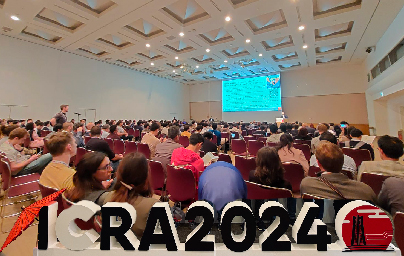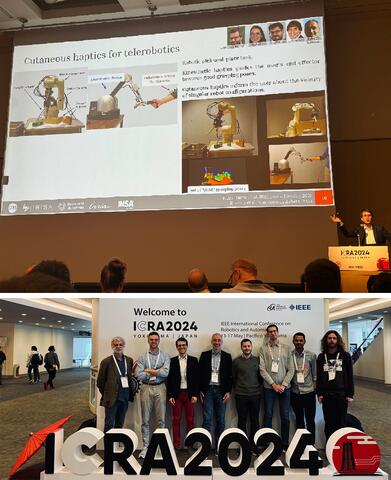

Claudio Pacchierotti, keynote speaker at ICRA2024 (Yokohama, Japan)
Claudio Pacchierotti, CNRS researcher and member of the research team Rainbow, holder of the CNRS Bronze Medal and coordinator of the Horizon Europe RĔGO project, has been invited as a keynote speaker at the International Conference on Robotic and Automation (ICRA) to present his research in Haptics.
ICRA is the leading international conference dedicated to robotics and automation. This annual event brings together researchers, engineers and industry professionals to present the latest advances and innovations in these fields.
The sense of touch is essential to our interactions with the environment and our fellow human beings. Without it, we wouldn't be able to manipulate an object, or even walk,” he explains. “It's this gap between the relevance and importance of haptics, and what technology is capable of doing today, that drew me to this very subject.
Image

Claudio Pacchierotti is in fact a recognized expert in cutaneous haptics. Thanks to haptic technologies, it is now possible to recreate the sensations of pressure and touch, or to interact physically with a virtual or remote object.
Combining robotics, systems and control theory, computer science, mechatronics and psychophysics, haptics is a highly interdisciplinary field of research. The development of haptic devices in medical technologies, for example, which can assist a surgeon through vibration feedback. This is what Claudio Pacchierotti and the consortium, including researchers from France with CNRS, Inria and CHU de Rennes, from the Netherlands with the University of Twente, from Germany with Helmoholtz-Zentrum Dresden Rossendorf, from Italy with Scuola Superiore Sant'Anna and Instituto Italiano di Tecnologia and in partnership with the company Haption SA. are seeking to develop in the Horizon Europe project that he coordinates called RĔGO.
RĔGO aims to develop an innovative set of AI-driven robot swarms, these being small, untethered and sensitive to stimuli. The micro-robots will be directed wirelessly by electromagnetic fields and respond to other external stimuli, jointly directed by humans via intuitive multisensory interfaces. Like ants and multi-drone systems, RĔGO robots will be able to team up and collaborate to accomplish highly complex tasks in a robust, scalable and flexible way.
Claudio Pacchierotti will present the progress of his research at a keynote entitled “Beyond Force Feedback: Cutaneous Haptics in Human-centered Robotics,” on Tuesday, May 14, 2024, in Yokohama.
As robotics progresses towards more integrated, human-centered applications, haptic feedback plays a crucial role in the seamless connection between humans and robots. While force feedback has traditionally played a crucial role, this paper explores the untapped potential of cutaneous haptics to create more natural, richer and safer interactions in human-centered robotics. Claudio Pacchierotti will share his thoughts on the role of cutaneous and kinesthetic haptics in robotics. He will present the design of innovative cutaneous haptic interfaces and rendering techniques, and their application in human-centered robotics and immersive environments. By emphasizing a holistic and multimodal approach to haptic feedback, this talk aims to inspire researchers and engineers to explore cutaneous haptics for developing the next generation of human-robot sensory interfaces.
RĔGO aims to develop an innovative set of AI-driven robot swarms, these being small, untethered and sensitive to stimuli. The micro-robots will be directed wirelessly by electromagnetic fields and respond to other external stimuli, jointly directed by humans via intuitive multisensory interfaces. Like ants and multi-drone systems, RĔGO robots will be able to team up and collaborate to accomplish highly complex tasks in a robust, scalable and flexible way.
Claudio Pacchierotti will present the progress of his research at a keynote entitled “Beyond Force Feedback: Cutaneous Haptics in Human-centered Robotics,” on Tuesday, May 14, 2024, in Yokohama.
As robotics progresses towards more integrated, human-centered applications, haptic feedback plays a crucial role in the seamless connection between humans and robots. While force feedback has traditionally played a crucial role, this paper explores the untapped potential of cutaneous haptics to create more natural, richer and safer interactions in human-centered robotics. Claudio Pacchierotti will share his thoughts on the role of cutaneous and kinesthetic haptics in robotics. He will present the design of innovative cutaneous haptic interfaces and rendering techniques, and their application in human-centered robotics and immersive environments. By emphasizing a holistic and multimodal approach to haptic feedback, this talk aims to inspire researchers and engineers to explore cutaneous haptics for developing the next generation of human-robot sensory interfaces.
Author: Benoît Josset
